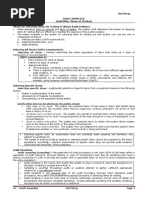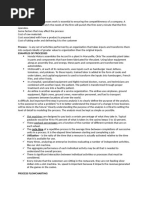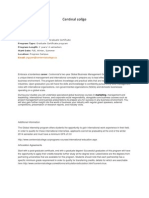Audit-Sampling
Audit-Sampling
Uploaded by
karryl barnuevoCopyright:
Available Formats
Audit-Sampling
Audit-Sampling
Uploaded by
karryl barnuevoCopyright
Available Formats
Share this document
Did you find this document useful?
Is this content inappropriate?
Copyright:
Available Formats
Audit-Sampling
Audit-Sampling
Uploaded by
karryl barnuevoCopyright:
Available Formats
Audit Sampling:
Audit sampling is the process by which an auditor selects and tests a representative portion of a
population (such as transactions or balances) to draw conclusions about the entire population. Since it’s
often impractical to test every item in a population due to time, cost, or resource constraints, audit
sampling helps auditors make informed judgments about the financial statements based on a subset of
data.
Steps in Audit Sampling:
The steps in audit sampling generally include the following:
1. Define the Objective of the Sampling:
o The auditor needs to identify the purpose of the sampling. For example, it could be to
test the accuracy of account balances or the effectiveness of internal controls. The
objective helps guide the selection and evaluation of the sample.
2. Define the Population:
o The population refers to the entire set of items that the auditor intends to draw the
sample from (e.g., all sales transactions, all invoices, or all inventory items). The
population should be clearly defined so the auditor can ensure that the sample selected
is representative.
3. Determine the Sample Size:
o The sample size is based on factors such as:
The desired level of assurance (confidence level)
The acceptable level of misstatement or error (tolerable error)
The variability or risk within the population
The auditor's professional judgment
o Larger sample sizes typically increase the reliability of the results but also require more
time and resources.
4. Select the Sample:
o There are various methods for selecting a sample, such as:
Random Sampling: Items are selected randomly, ensuring each item has an
equal chance of being chosen.
Systematic Sampling: Items are selected using a fixed interval (e.g., every 10th
transaction).
Stratified Sampling: The population is divided into subgroups or strata, and
samples are selected from each subgroup.
Judgmental Sampling: The auditor uses professional judgment to select specific
items, often based on perceived risks or significance.
5. Perform the Audit Procedures on the Sample:
o Once the sample is selected, the auditor performs the audit procedures on the sample
items. These procedures may involve inspecting documents, verifying transactions,
performing recalculations, or testing controls.
6. Evaluate the Results of the Sample:
o After testing the sample, the auditor assesses the findings and draws conclusions about
the entire population. This step involves:
Evaluating whether any misstatements or errors found in the sample are
significant enough to affect the overall financial statements.
Using statistical methods (if applicable) to project the findings from the sample
to the entire population.
Considering whether the sample results meet the tolerable error levels and
whether further testing is needed.
7. Form an Opinion and Conclude:
o Based on the evaluation of the sample results, the auditor forms an opinion on the
financial statements, internal controls, or specific audit objectives. If the sample results
indicate errors or weaknesses, the auditor may expand the sample or perform additional
procedures.
Key Considerations in Audit Sampling:
Sampling Risk: The risk that the sample selected does not represent the population and leads to
incorrect conclusions.
Non-Sampling Risk: The risk that the auditor makes an incorrect conclusion based on
misinterpretation or improper application of audit procedures.
By following these steps and applying appropriate sampling techniques, auditors can efficiently gather
evidence that helps form their audit opinion while managing resource constraints.
You might also like
- CPWD Maintenance Manual 2019Document81 pagesCPWD Maintenance Manual 2019Raja75% (4)
- Chapter One Auditing SamplingDocument5 pagesChapter One Auditing SamplingBantamkak FikaduNo ratings yet
- What Is Audit SamplingDocument4 pagesWhat Is Audit Samplingms1676514No ratings yet
- Chapter 9 Audit SamplingDocument17 pagesChapter 9 Audit SamplingCzarmae DumalaonNo ratings yet
- Chapter 9 Audit SamplingDocument17 pagesChapter 9 Audit SamplingMAG MAGNo ratings yet
- Various Means of Gathering Audit EvidenceDocument14 pagesVarious Means of Gathering Audit EvidenceCRAZY SportsNo ratings yet
- Lecture 7a Audit Sampling and Analytical Procedure-Fatema Saleh IsaDocument33 pagesLecture 7a Audit Sampling and Analytical Procedure-Fatema Saleh IsaalooyxvNo ratings yet
- Topic 1Document35 pagesTopic 1fbicia218No ratings yet
- Audit IiDocument187 pagesAudit IiBantamkak FikaduNo ratings yet
- AT Module 6C Audit Sampling T2AY2324Document10 pagesAT Module 6C Audit Sampling T2AY2324pht2airdropNo ratings yet
- Auditing 2Document6 pagesAuditing 2Lemma AberaNo ratings yet
- Chapter 11 - Audit Sampling Concepts - NotesDocument9 pagesChapter 11 - Audit Sampling Concepts - NotesSavy DhillonNo ratings yet
- SAMPLING SLIDESDocument21 pagesSAMPLING SLIDESAndiswa MabuzaNo ratings yet
- Audit Ii CH-1Document44 pagesAudit Ii CH-1GetnetNo ratings yet
- Audit Sampling.2024Document48 pagesAudit Sampling.2024najiath mzeeNo ratings yet
- Ch-One AuditDocument27 pagesCh-One Auditmesfinabera180No ratings yet
- Chapter Eleven Basic Audit and Sampling Concepts: Auditing and Assurance PrinciplesDocument25 pagesChapter Eleven Basic Audit and Sampling Concepts: Auditing and Assurance Principlesfaye anneNo ratings yet
- 1. Auditinig Assignment OneDocument16 pages1. Auditinig Assignment Onederesebishaw5No ratings yet
- Activity Sheet - Module 8Document12 pagesActivity Sheet - Module 8Chris JacksonNo ratings yet
- Audit SamplingDocument40 pagesAudit SamplingJasmin BasimNo ratings yet
- CH - 1 AUDITING PRINCIPLES AND PRACTICES-II STDocument10 pagesCH - 1 AUDITING PRINCIPLES AND PRACTICES-II STAyana Giragn AÿøNo ratings yet
- Audit Principle and Practice II CH 1Document26 pagesAudit Principle and Practice II CH 1natnaelsleshi3No ratings yet
- Audit SamplingDocument18 pagesAudit SamplingAhmed AlifNo ratings yet
- Audit Sampling: APT Financial ConsultantsDocument14 pagesAudit Sampling: APT Financial ConsultantsMurali KrishnanNo ratings yet
- At 13Document10 pagesAt 13Jean Fajardo BadilloNo ratings yet
- audit samplingDocument4 pagesaudit samplingunaylovelyjoy47No ratings yet
- Audit SamplingDocument15 pagesAudit Samplingmdakash199705No ratings yet
- At.114 Audit SamplingDocument8 pagesAt.114 Audit SamplingmiolataNo ratings yet
- Chapter 11Document38 pagesChapter 11faye anneNo ratings yet
- Basic Audit Sampling ConceptsDocument2 pagesBasic Audit Sampling ConceptsPam IntruzoNo ratings yet
- Audit SamplingDocument4 pagesAudit SamplingheneclintonnorgeNo ratings yet
- This Type of Audit Risk Affects Audit EfficiencyDocument12 pagesThis Type of Audit Risk Affects Audit EfficiencyJBNo ratings yet
- Chapter OneDocument27 pagesChapter OneHabtewold AlemnewNo ratings yet
- AUDITING PRINCIPLES AND PRACTICES II CHAPTER ONEDocument18 pagesAUDITING PRINCIPLES AND PRACTICES II CHAPTER ONEabaynehgedionNo ratings yet
- CH-1Document17 pagesCH-1GetnetNo ratings yet
- TOPIC 3c Audit SamplingDocument38 pagesTOPIC 3c Audit Sampling2019847974No ratings yet
- Audit Sampling 1Document15 pagesAudit Sampling 1Nabeel IftikharNo ratings yet
- Audit II CH1Document56 pagesAudit II CH1tame kibruNo ratings yet
- AUDITING PRINCIPLES P II CH One PartDocument17 pagesAUDITING PRINCIPLES P II CH One Partmelkamuaemiro1No ratings yet
- Audit Sampling: Aud TH Ho Module A Sampling Dr. Jackqui MorenoDocument11 pagesAudit Sampling: Aud TH Ho Module A Sampling Dr. Jackqui Morenoprincess lyneNo ratings yet
- Understanding The POPULATION For Audit SamplingDocument6 pagesUnderstanding The POPULATION For Audit SamplingAnthony Koko CarlobosNo ratings yet
- Chapter 1 & 2Document12 pagesChapter 1 & 2Tesfahun tegegnNo ratings yet
- TOPIC 3c - Audit SamplingDocument38 pagesTOPIC 3c - Audit SamplingLANGITBIRU100% (1)
- Audit Sampling and TechniqueDocument32 pagesAudit Sampling and TechniqueShinosuke ExtendezNo ratings yet
- 3 Auditing Techniques and Internal AuditDocument30 pages3 Auditing Techniques and Internal Audit3257 Vibhuti WadekarNo ratings yet
- TTTTTTTTTTTTDocument31 pagesTTTTTTTTTTTTRalph MindaroNo ratings yet
- BAB 32 Sampling: Items Yang Mewakili Populasi - Merupakan Cara Yang Tepat UntukDocument7 pagesBAB 32 Sampling: Items Yang Mewakili Populasi - Merupakan Cara Yang Tepat UntukAriefah FufahNo ratings yet
- AuditingDocument3 pagesAuditingJames SyNo ratings yet
- Psa 530: Audit Sampling and Other Selective TestingDocument49 pagesPsa 530: Audit Sampling and Other Selective TestingJeric IsraelNo ratings yet
- Chap 7Document6 pagesChap 7ChiNo ratings yet
- 7 Audit SamplingDocument10 pages7 Audit SamplingPooja RaiNo ratings yet
- Chapter 1Document8 pagesChapter 1mulu melakNo ratings yet
- Riftyvally University College: Auditing Principles and Practice Ii Assignment Group 9Document9 pagesRiftyvally University College: Auditing Principles and Practice Ii Assignment Group 9FekaduNo ratings yet
- Sampling Techniques in AuditDocument3 pagesSampling Techniques in AuditxxxfarahxxxNo ratings yet
- Audit Sampling ModuleDocument7 pagesAudit Sampling ModuleFery AnnNo ratings yet
- Pa 2320-3 PDFDocument4 pagesPa 2320-3 PDFaian joseph100% (1)
- Chapter One: 1. Audit SamplingDocument6 pagesChapter One: 1. Audit SamplingZelalem HassenNo ratings yet
- At Audit SamplingDocument9 pagesAt Audit SamplingjeromyNo ratings yet
- Audit-Sampling PDFDocument9 pagesAudit-Sampling PDFPablo Limachi GomezNo ratings yet
- audit-evidenceDocument1 pageaudit-evidencekarryl barnuevoNo ratings yet
- Substantive-TestsDocument3 pagesSubstantive-Testskarryl barnuevoNo ratings yet
- IMPORTANT TERMDocument1 pageIMPORTANT TERMkarryl barnuevoNo ratings yet
- Steps-in-Completing-the-AuditDocument4 pagesSteps-in-Completing-the-Auditkarryl barnuevoNo ratings yet
- Working-PaperDocument3 pagesWorking-Paperkarryl barnuevoNo ratings yet
- VCMDocument9 pagesVCMkarryl barnuevoNo ratings yet
- GENERALLY ACCEPTED ACCOUNTING PRINCIPLESDocument1 pageGENERALLY ACCEPTED ACCOUNTING PRINCIPLESkarryl barnuevoNo ratings yet
- FINALS REVIEWER FOR RIZALDocument1 pageFINALS REVIEWER FOR RIZALkarryl barnuevoNo ratings yet
- Document (1)Document1 pageDocument (1)karryl barnuevoNo ratings yet
- OM and TQM REVIEWER FOR PRE-FINALSDocument4 pagesOM and TQM REVIEWER FOR PRE-FINALSkarryl barnuevoNo ratings yet
- Midterm Reviewer For Om and TQMDocument5 pagesMidterm Reviewer For Om and TQMkarryl barnuevoNo ratings yet
- Om and TQM PreliminariesDocument7 pagesOm and TQM Preliminarieskarryl barnuevoNo ratings yet
- Womens of RizalDocument14 pagesWomens of Rizalkarryl barnuevoNo ratings yet
- Chapter 16 - Corporate GovernanceDocument34 pagesChapter 16 - Corporate Governancekarryl barnuevoNo ratings yet
- Rizal ReviewerDocument9 pagesRizal Reviewerkarryl barnuevoNo ratings yet
- Hilot STS ProjectDocument2 pagesHilot STS Projectkarryl barnuevoNo ratings yet
- Temples in MyanmarDocument1 pageTemples in Myanmarpromodai122No ratings yet
- Concept PaperDocument4 pagesConcept PaperSean Lei Gordula TaborNo ratings yet
- Adventist Church Term PaperDocument12 pagesAdventist Church Term PaperJP MaristelaNo ratings yet
- Nissan Motor Company - Profile With SWOT AnalysisDocument4 pagesNissan Motor Company - Profile With SWOT AnalysisMJ Villamor Aquillo100% (1)
- Proper Adjectives - Worksheet 1-4Document7 pagesProper Adjectives - Worksheet 1-4entaledigitalNo ratings yet
- Table of Specification Summative Test in Math 6 (1 Quarter) S.Y. 2019-2020Document1 pageTable of Specification Summative Test in Math 6 (1 Quarter) S.Y. 2019-2020manilynNo ratings yet
- NCP 1117Document17 pagesNCP 1117niko_naNo ratings yet
- Boiler Material and Typical ApplicationsDocument1 pageBoiler Material and Typical Applicationsmtbecerrap100% (1)
- Centinal CollgeDocument17 pagesCentinal CollgeAdit KadakiaNo ratings yet
- Ddgs Handbook FullDocument123 pagesDdgs Handbook FullJohn Torrez100% (1)
- Muhammad Syazwan Bin Abd Rahman GS40160Document10 pagesMuhammad Syazwan Bin Abd Rahman GS40160Ikhwan AlifNo ratings yet
- Abnormal Psychology 7th Edition by Susan Nolen Hoeksema-Test BankDocument60 pagesAbnormal Psychology 7th Edition by Susan Nolen Hoeksema-Test BankakasagillNo ratings yet
- Bariatric CookbookDocument36 pagesBariatric CookbookMarcela SalgadoNo ratings yet
- Sources For Nelson Mandela History ProjectDocument4 pagesSources For Nelson Mandela History Projectapi-498174875No ratings yet
- Asme Section Ii B SB-148Document6 pagesAsme Section Ii B SB-148Vania Navarro CárdenasNo ratings yet
- Update DeailsDocument75 pagesUpdate DeailsNehalNo ratings yet
- Nursing Home ComplaintDocument55 pagesNursing Home ComplaintLaura NahmiasNo ratings yet
- OSI and TCP/IP ModelDocument35 pagesOSI and TCP/IP ModelSwapnil agrawalNo ratings yet
- An Experiment On Ground Water by Geo Physical InvestigationsDocument14 pagesAn Experiment On Ground Water by Geo Physical InvestigationsAll in one TECHYNo ratings yet
- Merchandising BusinessDocument11 pagesMerchandising BusinessABM-AKRISTINE DELA CRUZNo ratings yet
- Trados Studio 2024Document10 pagesTrados Studio 2024sharnobyNo ratings yet
- Larchfield - Chapter 1 & 2Document21 pagesLarchfield - Chapter 1 & 2Quercus Books100% (1)
- AVN2003Document130 pagesAVN2003Kate SquiresNo ratings yet
- Baby Boy NamesDocument93 pagesBaby Boy Namesvishnu051086No ratings yet
- DolphinDocument5 pagesDolphinShalini VaidNo ratings yet
- Conversation 1: Would You Like To Come? They Have Lots of Animals To SeeDocument2 pagesConversation 1: Would You Like To Come? They Have Lots of Animals To SeePavithra VigneshwaranNo ratings yet
- DETAILED LP IN MATHEMATICS KG KhayeDocument5 pagesDETAILED LP IN MATHEMATICS KG KhayeBernadette Kaye CornejoNo ratings yet
- Examples in Thermodynamics Problems - W. R. CrawfordDocument71 pagesExamples in Thermodynamics Problems - W. R. CrawfordJom BonhayagNo ratings yet
- 《HSK标准教程1》课件 HSK1 L5Document40 pages《HSK标准教程1》课件 HSK1 L5王萌哲No ratings yet









































































































